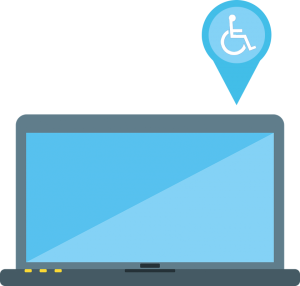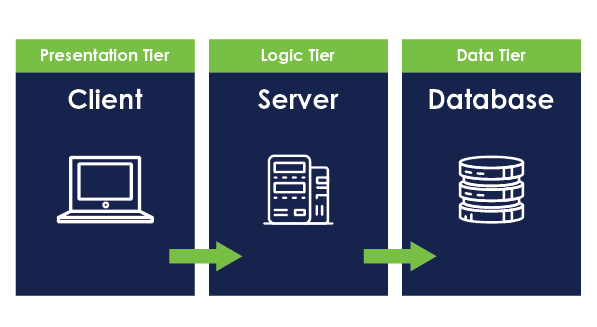The buzz around Artificial Intelligence (AI) is deafening. The increasing capabilities…
Due to the global pandemic, there has been a drastic change in the adoption of online business. As one can imagine, altering the way companies deliver their services to customers proposes a variety of challenges, but there is one major challenge that many companies have failed to take into account: how accessible is our online content?
What is web accessibility?
Web Accessibility is the practice of making sure that your website or app is accessible to as many users as possible, and is typically focused on users with disabilities. If developers even take accessibility into consideration, most will focus on making sure their content is suitable for the most prominent disabilities: blindness, deafness, and seizure disorders. However, many other types of disabilities can affect the user experience, including color blindness, dyslexia, motor control disorders, learning disabilities, and old age. All of these have one thing in common: they make the user experience vastly different from what a developer envisions when they design a website – and often that experience is difficult and frustrating. Let’s go through some examples: three very hungry customers who are trying to order a pizza online.

Customer 1
Our first customer, Alice, is legally blind. She still has vision, but even with correction, it’s significantly blurred. So, Alice uses a screen reader on her laptop to help her navigate through websites. There are designated keys on the keyboard that she can use to direct the screen reader to read the content of a page out loud. However, she seems to be running into some trouble on the page where she decides the toppings for her pizza: the web designer chose to make all of the topping choices images with no alternative text. While a normal user can see all the toppings and make their choice, Alice can only see the colors and general outlines of the images. All she can hear is the screen reader saying “image” over and over as she selects each topping. Alice is not able to order her pizza.
Customer 2
Our second customer, Luís, is red-green color-blind. He’s picked his pizza toppings and is now trying to submit his address and contact information. The problem is, the form won’t submit. All of the fields are outlined in yellow, and no matter how many times he changes the information and tries again, the website won’t let him continue. What Luís doesn’t know is that his phone number is in the wrong format and the field is outlined in red to indicate the error. The website designer chose to highlight valid fields in green and invalid fields in red when the form is submitted. But for someone who is red-green colorblind, they all look the same. After trying again and again, Luís gives up. He isn’t able to order his pizza.
Customer 3
Our third customer, Hana, is deaf. The website has had an update since the last time she used it. To order a pizza, you must create an account. However, the security has also been updated – every user must set up multi-factor authentication. After logging in, Hana is asked for her phone number. A voice call with a one time code will be sent to her so she can verify that it’s her who is logging in. Unable to hear a voice call, Hana isn’t able to log in to her account and order a pizza.
The pizza store has now lost three very frustrated, very hungry almost-customers.
Now, these scenarios may seem a little ridiculous. Surely, a real pizza store’s website would include text to indicate the name of the topping under the image of it. It would have an error message pop up on the screen to indicate that the phone number is in the incorrect format. And if it even bothered to have multi-factor authentication, the code would also be sent as a text message or an email. But the thing is, there are real websites out there that have similarly inaccessible designs (and similarly terrible user experiences). One of those websites was Dominos. In 2019, a blind man sued them because he was unable to order a pizza on either their website or through their app.
Why Web Accessibility Matters
The Domino’s case isn’t the only one. According to the accessibility firm UsableNet, in the past year, there have been 3,550 ADA-related digital lawsuits, a 23% increase from 2019. With this growing demand for accessible online business, companies need to start paying attention to accessibility. However, accessibility updates are often time and resource consuming. So what’s the incentive?
For most companies, the biggest reason to become accessible is to decrease the risk of a lawsuit. The cost of lawyer fees and settlements, on top of the cost of making the updates post-lawsuit, isn’t worth it compared to the upfront costs of making a website or app accessible. For others, accessibility updates open up their business to a much wider audience. This is especially true right now when many companies are unable to provide in-person services due to policies regarding COVID-19. An accessible website means that they can provide those services or products that disabled users may not be able to get anywhere else.
And finally, many companies make their online content accessible to boost their brand perception. According to the CDC, there are 61 million people in the U.S. who have a disability, and a large percentage of that number are people with disabilities that can affect their ability to interact with online content. Having an accessible website is also a statement that your company hasn’t disregarded those 61 million people who have a different user experience than “typical” customers.
Better Your Business
So how do you make sure that your online content is accessible? Unfortunately, slapping an “accessibility” widget on the website and calling it good isn’t enough – a comprehensive audit of the website or app needs to be done. This audit will find violations of a set of international accessibility standards called the Web Content Accessibility Guidelines, or the WCAG. These guidelines have been compiled to define what an “accessible” website is. The WCAG has three levels of conformance: A, AA, and AAA. Level A is usually considered the “bare minimum” of conformance, while Level AAA is the highest. Each technical standard defined in the WCAG will describe what needs to be done to conform to each level. Most companies tend to settle for AA compliance, as AAA compliance sometimes forces changes to the UI/UX that they may not want to make. However, the higher the level of compliance with the WCAG, the more likely it is that the website has a better user experience, even for those without disabilities.
The audit usually starts with an evaluation of the user interface. The structure and presentation of each page must be intuitive and easy to use. Updates to improve these aspects may include changing the layout to make a page less cluttered and simplifying the language. This is also the step where the more drastic UI changes will be decided, such as updating the color scheme to make sure it has sufficient contrast. After that comes the more glaring accessibility problems – things on the page that not every user can access. Text and images need to be able to be described by a screen reader, and audio and videos need to have captions or transcripts. On top of that, link and button descriptions should be accurate in terms of where they will take the user when clicked on. After that, other parts of the website that may need a more unique solution will be evaluated. This includes charts, graphs, animations, dashboards, and interactive elements like forms.
Now, that’s a lot to remember, and these high-level items don’t even begin to cover all of the accessibility standards set forth by the WCAG. How does an auditor keep track of it all? A good auditor will use two different types of testing: automated and manual. There are a variety of automated accessibility checkers available today, from free web extensions to paid applications. Most of them offer automated tests that will check a page for obvious WCAG violations, such as insufficient color contrast and heading levels being out of order. While the results from these automated tests are useful and save a lot of time, they aren’t enough in terms of verifying that all the content on a page is accessible. Manual testing with a screen reader is essential, along with an auditor who has a good grasp of the standards in the WCAG. Simulating a user’s journey as they navigate through each page with a screen reader allows the auditor to find some very serious accessibility issues that automated tools can’t pick up. Often the auditor will be able to find that there are certain elements that are completely inaccessible to a screen reader or certain design choices that may be very annoying in terms of user experience.
Unlike Pizza, Accessible Content Can’t be Topped
The results of a web accessibility audit can be overwhelming at times. Hundreds of violations, whether small or large, can be found. Seeing so many issues and having a set budget or timeline to fix them can prompt the question: do we really need to fix all of this? The answer to that is yes. While disabled users may not be able to have the same user experience as other users, that doesn’t mean that they can’t have a good user experience. It is important to make these changes to be legally compliant and to give all users the best experience possible, but you don’t have to tackle this initiative on your own. Zirous, a trusted IT partner for 35 years, is here to help you along your accessibility journey. Contact us for a free initial assessment to help you get started.







This Post Has 0 Comments